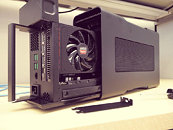Monday, February 29th 2016

AMD Pushes for a Universal External Graphics Standard
AMD is working on a standardized external graphics solution for notebooks. This solution will allow people with ultra-thin notebooks to enjoy the mobility served up by frugal, mainstream hardware; as well as high-end gaming, with the graphics card plugged in at home. It also probably gives AMD greater control over design and cooling solutions. Unlike a mobile GPU that sits inside your notebook, and makes it bulky due to additional cooling and power requirements, an external graphics card sits on your desk, sipping on wall socket power.
AMD's external graphics solution isn't necessarily an AMD-branded piece of hardware, but rather an open specification for notebook vendors to follow. AMD will merely provide the GPUs and software ecosystem that makes the solution truly universal and plug-n-play, with "standardized connectors, cables, drivers, and OS support." Such a graphics card will interface with just any notebook with a high-speed interface (eg: Thunderbolt). Its drivers will make it crunch your games, while sending back output to your notebook's display, over the same connection. This gives you the mobility of an ultra-thin notebook. You should also be able to plug this into your work's boring Dell desktop, or any SFF ITX box. Pictured below is a Razer Core graphics solution embedding a Radeon R9 Nano. Other examples include MSI Gaming Dock and Alienware Graphics Amplifier.
Sources:
Robert Hallock on Facebook, Forbes
AMD's external graphics solution isn't necessarily an AMD-branded piece of hardware, but rather an open specification for notebook vendors to follow. AMD will merely provide the GPUs and software ecosystem that makes the solution truly universal and plug-n-play, with "standardized connectors, cables, drivers, and OS support." Such a graphics card will interface with just any notebook with a high-speed interface (eg: Thunderbolt). Its drivers will make it crunch your games, while sending back output to your notebook's display, over the same connection. This gives you the mobility of an ultra-thin notebook. You should also be able to plug this into your work's boring Dell desktop, or any SFF ITX box. Pictured below is a Razer Core graphics solution embedding a Radeon R9 Nano. Other examples include MSI Gaming Dock and Alienware Graphics Amplifier.

21 Comments on AMD Pushes for a Universal External Graphics Standard
It might be useful with faster processors in systems that don't have a graphics option, but price will be a determining factor.
It may be cheaper to build an entire new system.
secondly, it would go completely against what a console is, a contained controlled system that everything works for that was made for it.
Otherwise it would just be a pc.
And what good games are you referring to that are "from console".
Pretty much all huge titles are made for PC and consoles at the same time.
CPUs in my notebooks are fast enough. Can't say the same about GPUs.
Would play XCOM 2 on a notebook, if it could handle it. =/
This will end up be a solution solely for laptop users who want to game while at home but not have to buy a gaming laptop.
www.theguardian.com/technology/2016/mar/01/microsoft-to-unify-pc-and-xbox-one-platforms-ending-fixed-console-hardware?CMP=twt_gu
You are probably only looking at a total dissipation requirement of at most 50 watts continuous, add a GPU, and you need to at least double that. My old GT60 consumed around 140-150w during a BF3 gaming session, the GPU was probably around 2/3 of that.
With a quad core laptop CPU (~3.5GHz turbo) you should easily be able to back up a GTX 980, and in many games even a 980 Ti. Just look at how much trouble they are having putting a fast GM204 in a massive 17 inch hulk... Put the GPU outside the laptop and you've literally solved all your problems.